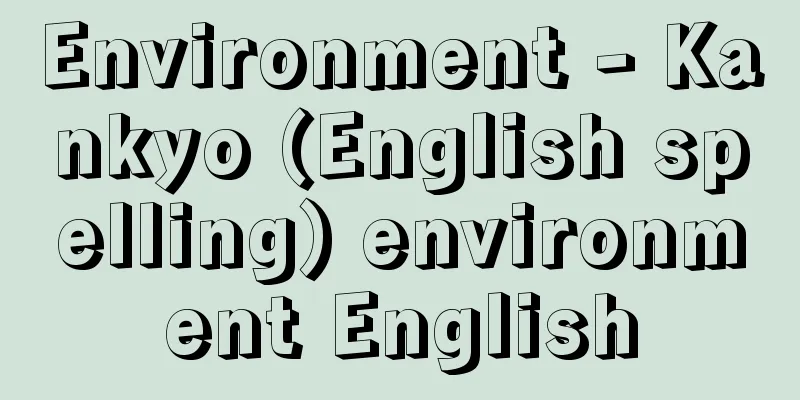Environment - Kankyo (English spelling) environment English

Environmental ConceptEnvironment and SubjectsThe things and conditions surrounding a certain thing (person) are called the thing's environment, and the thing is called the subject. Strictly speaking, the specific content of the environment differs for each individual subject, such as "you are part of my environment, and I am part of your environment." Therefore, when dealing with the environment, it is inseparably required to clarify what is the subject. Anything can be taken as the subject. When talking about the environment of living things, the subject is usually the individual, but the environment is often also used to refer to groups of individuals, such as families, flocks, or communities, or even cells within the body. Also, between similar things that exist in close proximity to one another, such as the individual cedars that make up a cedar forest, the environments of these are generally very similar, and for convenience they are considered to be in the same environment, so the common environment is often meant in general terms, without specifically designating a specific individual as the subject. The environment is made up of all kinds of substances and objects, but their form is also considered to be part of the environment. In other words, important environmental factors for living things include water, oxygen, nutrients, food organisms, enemies, as well as light, temperature, currents, and pressure. Liquid water is not the same as solid ice, and water and salts separately is not the same as salt water. Factors such as water quality and sediment are complex, meaning not only what substances are contained, but also the state of the concentration, particle size, and spatial and temporal changes. [Hideji Harada] Environmental ScopeThe scope of the environment for a subject cannot be limited in theory, but is considered to be infinitely expanding. In some cases, distant objects such as a view can be directly important, while in other cases, noise and odors can be problematic even if their source is far away. In human society, events in other countries often have direct meaning through information. When we consider the spread of influences and the propagating nature of relationships, it becomes even more impossible to limit the scope of the environment. On the other hand, a subject is only influenced when the action of the environment directly affects the subject in some way. It is not realistic to always deal with an environment that is infinitely expanding. Therefore, it is common to first consider the appropriate nearby scope with which the subject has direct contact, that is, the proximate environment, as the environment. When parts or factors in the environment that have direct importance to the subject are recognized, they are sometimes called the effective environment. In living organisms, such effective environments and their meanings usually differ from species to species and from individual to individual. In the case of humans, differences in the evaluation of the environment arise due to differences in values. The image of the environment perceived by the subject in this way is called the subjective environment, and it can be said that each living being is in its own subjective environment. However, even if the effective environment and the subjective environment are important to the subject, their contents are not clear from the beginning, but are known only after an analysis of the relationship between the subject and the environment as an objective entity. The part of the environment extracted in anticipation of its involvement with the subject is called the operational environment, and is the immediate target of concrete handling such as measurement and analysis. The environment is often understood in limited scope or aspect, such as the home environment, educational environment, water environment, or biological environment. Some positions reject the idea that everything outside is the environment as a naive, unlimited theory of the environment, and define the environment as that part of the external world that is involved with the subject and is necessary for the subject. There is also the view that the interior of an organism is maintained in a specific state (homeostasis) that is involved in its survival, and that this is the internal environment in contrast to the external environment. When the term environment is used, it is often unclear what it actually refers to. [Hideji Harada] The concept of the global environmentMeanwhile, the expansion of human activities has brought about changes in the environment all over the globe, and the concept of the "global environment" has come to attract attention in relation to the scope of the environment. The global environment generally refers to the living environment for humans, that is, the human environment (not referring to the human part of the environment in isolation), viewed from a global perspective. It can also be used to refer to other living organisms, but in any case, it is based on the recognition that environmental issues have aspects that must be understood and considered on a global scale. For example, global warming, which is predicted to bring about natural changes on a global scale, such as rising sea levels and widespread forest changes, is partly caused by carbon dioxide emitted into the atmosphere in various parts of the world. In order to prevent such changes to the global environment, it is essential to remove the causes in each part of the world. Emphasis is placed on the recognition of the local nature of the phenomenon as the cause, the widespread nature of the phenomenon as the result of its influence, and the transformation of local events into global issues (globalization). It is now widely recognized that humans themselves must pay attention to the enormous impact that human activities have on the global environment and the natural environment of each region, and take corrective measures. This is exemplified by the Rio de Janeiro Declaration (1992) at the United Nations Conference on Environment and Development, which called for environmental protection. In Japan, the Basic Environment Law was enacted in 1993, followed by the Environmental Impact Assessment Law in 1997, and so-called environmental assessments began to be carried out. In addition, activities by private organizations known as environmental NGOs and environmental NPOs, as well as nature conservation movements, are also exerting their influence. However, there is a large gap between this and an economic-first orientation, and many issues remain to be addressed. [Hideji Harada] Environment and Living ThingsEnvironmental Conditions and AdaptationThe specific state and level of environmental factors, such as the moisture content of the soil, the soil's particle size composition, the temperature, and the type and amount of food available, are called environmental conditions. The environmental conditions that are suitable for an organism vary from species to species for each environmental factor, and usually change with the stage of growth and development. There are also individual differences. Some plants, such as sea cucumber, grow on sunny beaches on the coast, while other ferns grow in colonies on damp rocks in deep mountain forests. Even trees such as Japanese oak, whose crowns are exposed to direct sunlight as they grow, tend to grow well as sprouts and young trees as undergrowth in the shade beneath other trees. Environmental conditions vary from place to place and change from moment to moment. While there are slight differences, such as the oxygen concentration in the air or the salinity of open ocean water, there are clear changes in oxygen concentration with altitude and in forests throughout the day. The amount of sunlight and temperature change greatly and regularly on a diurnal and annual (seasonal) basis. The intertidal zone of the coast is regularly submerged and evacuated by the tides, but on lake and river shores this occurs at no particular time. As the water submerges and evacuates, so do not only the moisture content but also the temperature, brightness, and oxygen concentration. Except for places such as the deep sea or underground caves, the environmental conditions in places where living things actually live generally fluctuate in certain ways, and living things adapt to these changes in order to survive. In particular, regular and periodic changes are incorporated into physiological activities, and in many cases have important meanings for the lives of living organisms, such as the photoperiod effect, in which changes in the length of daylight stimulate flowering. An environment that is favorable for the life of an organism can be understood to include such changes in environmental conditions. When we say change, we mean that adaptation is usually not observed to unexpected changes such as the introduction of unexpected substances such as air pollution or water pollution. The range of changes in environmental conditions that an organism can live and tolerate differs depending on the species, developmental stage, and environmental factors. If an organism has a wide range of tolerance to many factors, it can be widely distributed, but on the other hand, if that range is narrow for even just one factor, its life will be restricted by that. There are many examples, such as the Luehdorfia japonica butterfly, which requires Cannabis sativa for food for its larvae, which cannot reproduce unless Cannabis sativa grows. This is understood as a characteristic that organisms have formed and acquired during the process of evolution. [Hideji Harada] Environmental conditions and ecosystemsEnvironmental conditions create the framework for the habitat of living organisms, but they are inevitably subject to some changes as a result of the organisms' existence. When trees grow, the ground beneath them is shaded, and as fallen leaves decay, moist soil rich in organic matter is formed. When people flock to the beach to dig up the sand in search of the increased number of clams, they can harm not only the clams but also other organisms, and they can also change the bottom sediment that is their habitat. While embracing the work of such organisms, the exceptionally unique environmental conditions allow organisms to develop unique lifestyles and community structures. In the ocean and lakes, planktonic organisms have developed, and many animals have developed feeding patterns in which they filter these organisms from the water and use them as food, and breeding patterns in which their larvae live planktonic lives and disperse. Large plants cannot grow in the open ocean or deep lakes, and small algae that grow floating on the surface are responsible for the production of organic matter through photosynthesis, so large animals cannot eat them directly, and the food chain becomes longer. The relationship between living organisms and their environment is thus extremely multifaceted, and this forms the ecosystem. [Hideji Harada] Psychological and educational approachesThe environment means all the space in which the living entity (subject) is active. It can also be expressed as the living sphere. When viewed from the perspective of the living entity, the environment is restricted by the structure and function of the living entity and has its own unique content. Gestalt psychology was the first to consider the functional relationship between the living entity and the environment as a unified outside world. German psychologist K. Koffka distinguished the environment into the geographical environment and the behavioral environment, that is, the environment as it actually exists regardless of the presence or absence of the subject, and the environment as experienced by the person. The geographical environment is also called the physical environment. German psychologist K. Lewin was not satisfied with Koffka's dualism and presented the idea of living space. B = f (P E) is this, where B is behavior, P is personality and other personal factors, and E is the environment as perceived by the individual. f indicates that it is a function. In short, living space is made up of an interdependent relationship between the living entity and the environment. On the other hand, the environment is not opposed to living organisms, but is deeply connected to their life processes. Today, the phenomenon of environmental destruction has become a major issue. In this context, much research on the environment has been conducted not only in sociology, biology, and medicine, but also in psychology and education. Particularly noteworthy is the environmental psychology approach, which became popular in the United States in the latter half of the 1960s. There are almost no educational scholars who have not touched on environmental issues at all. Particularly famous is the "environmental pedagogy" of the German psychologist Adolf Busemann (1887-1968), which explained the interrelationship between humans and the environment from an educational perspective. "Environmental education," which was strongly promoted by the International Union for Conservation of Nature (IUCN) and the United Nations Educational, Scientific and Cultural Organization (UNESCO), which began their activities shortly after World War II, positioned understanding and interest in the environment as part of education against the backdrop of expanding environmental destruction on a global scale. The first environmental education in Japan was in the 1960s, in response to problems of pollution and environmental destruction. Then, in the year 2000, environmental education was introduced as part of the "integrated studies" newly introduced into the educational curriculum. Common themes include issues related to food, water, garbage, rivers, oceans, plants and animals, and towns (regions). [Kazuo Nishine] Environment and BehaviorHumans are surrounded by physical, geographical, and natural factors, as well as social and cultural factors. These are called the human environment. Therefore, what can be considered the human environment is not necessarily limited to visible things. It also includes social rules. Furthermore, an individual can be both a subject and an environment for another person. When considering human behavior, we cannot ignore the relationship with the environment. It can be said that behavior has the important function of adapting or adapting to the environment. [Ichiro Souma] Correspondence between environment and behaviorThere are three possible relationships between the environment and behavior: (1) exploration and manipulation, (2) approach and avoidance, and (3) environmental pressure and desire. (1) Exploration and manipulation Exploration behavior arises from the novelty of an object. It can be said to be an information-gathering behavior to take appropriate action in that environment. This behavior is often performed simply by moving the eyes, and can be said to be a behavior that is performed on a daily basis. Checking the behavior of people around you can also be said to be a type of exploratory behavior. Manipulation is a behavior in which humans influence the environment. When the environment changes as a result, the changed environment becomes a new stimulus and induces new behavior. (2) Approach and Avoidance Approach and avoidance are related to pleasant and unpleasant emotions. We approach objects that give us pleasant emotions and move away from objects that give us unpleasant emotions. This also includes "taking up space" (spacing). American cultural anthropologist E. T. Hall examined the relationship between the distance people take from others and interactions between individuals and found that people behave appropriately in interpersonal relationships at an appropriate interpersonal distance. In everyday interpersonal behavior, it is very rare that people are allowed to approach close to each other, and this space is guaranteed to be a minimum for each individual. However, in overcrowded situations or situations where the train is always crowded, it becomes difficult to maintain this space. A packed train is an extreme example. In this case, a situation of forced close contact is created, which is quite likely to increase discomfort. Therefore, it becomes difficult to carry out everyday interpersonal behavior. This spacing is also said to be related to privacy, etc. (3) Environmental pressure and desire Environmental pressure is the force exerted on an individual by the environment, and desire is the tendency to give cohesion and direction to a person's behavior. The correspondence between this pressure and desire establishes cognitive behavior. For example, how a student perceives school determines the student's behavior, and this is thought to be related to the student's deviant behavior. [Ichiro Souma] Study of behavior in specific environmentsHuman behavior is deeply related to the perception and evaluation of the environment. For this reason, many studies have been conducted on human behavior in specific environments. (1) Behavior during environmental transitions The central theme is the analysis of human behavior in new environments, which is also related to the "life transitions" from birth to death. (2) School environment and the behavior of children and students In this case, the central issue is the relationship between the behavior of the school and the physical structure, curriculum, personnel, etc. of the school. (3) Architectural space (architectural environment) and human behavior In this field, the relationship between spatial structure, behavior, and comfort is examined. (4) Urban space and human behavior This mainly deals with the image of the city, but research is also being conducted on the behavior of moving to a destination within the environment (way finding). (5) Human behavior during disasters This is research into behavior during disasters such as fires and earthquakes. Human behavior in abnormal environments is said to be prone to unclear directional judgment, spreading rumours and conformist behaviour, and is an important issue from the perspective of disaster prevention. However, because various conditions are intricately intertwined, there are many points in which it cannot be said that the results can be applied to all situations. In relation to all of these, imagery, cognitive maps (internal representations that individuals have of the spatial layout of their environment), and distance judgments have been examined, including their relationship to differences in information and experience. [Ichiro Souma] Simulated and real environmentsBy the way, today is said to be an information society, and preparations for the construction of an information environment are progressing rapidly. As a result, various types of information transmitted by mass media such as television flow in like a flood, forming a pseudo-environment (information environment) that symbolizes the real environment. In addition, a lot of information is transmitted by individuals through the Internet, etc. In such an information environment, the first problem is how each individual chooses to accept and reject information. In addition, how to disseminate information during a disaster is an important issue, and the spread of incorrect information can cause confusion. Although pseudo-environments can play a certain role in virtual training, there is a possibility that they may lack the excitement and affinity that can be obtained from real experience (real environment), which can lead to further emphasis on knowledge. How to deal with the recovery of humanity while keeping the problem of the information environment in mind will be a major challenge in the future. The relationship between humans and the environment uses not only visual and auditory senses but also various other senses. In that sense, in an information environment that relies too much on visual and auditory senses, the importance of real experience should be recognized. [Ichiro Souma] "Life and Science 7: Life and the Environment," edited by Tamiya Nobuo, Noda Haruhiko, et al. (1967, Kyoritsu Shuppan)" ▽ "Living Things and the Environment," written by Kawanabe Hiroya (1978, Jinbun Shoin)" ▽ "Reader in Ecology," edited by Numata Makoto (1980, Toyo Keizai Shinposha)" ▽ "Dictionary of Environmental Science," edited by Araki Takashi , Numata Makoto, and Wada Osamu (1985, Tokyo Kagaku Dojin)" ▽ "Dictionary of Global Environmental Terms," edited by E. Goldsmith and supervised translation by Fuwa Keiichiro and Ono Mikio (1990, Tokyo Shoseki)" ▽ "Global Environmental Report 2," written by Ishi Hiroyuki (Iwanami Shinsho)" ▽ "Environmental Psychology," written by Soma Ichiro and Sako Yoshihiko (1976, Fukumura Shuppan)" ▽ "Spatial Images of the Environment," edited by R.M. Downs and D. Steer, supervised translation by Yoshitake Yasumi (1976, Kajima Publishing Co.)" ▽ "Environmental Psychology," edited by Mochizuki Mamoru and Oyama Tadashi (1979, Asakura Publishing Co.) " ▽ "Complete Works of Education 15: School Environment Theory," by Nagakura Yasuhiko and Takahashi Hitoshi (1982, Daiichi Hoki Publishing)" ▽ "Educational Studies Training Course Volume 2: Educational Environment and Pathology," edited by Shinbori Michiya and Tsukanazawa Satoshihiro (1984, Daiichi Hoki Publishing)" ▽ "An Introduction to Environmental Education," by Fujiwara Eiji, Hirata Hisashi, Obara Hideo et al. (1987, Tokai University Press)" ▽ "Developmental Psychology of Life Transitions," edited by Yamamoto Takiji and S. Wapner (1992, Kitaoji Shobo)" ▽ "Modern School Education Encyclopedia 2" edited by Masatake Okuda and Shigeo Kono, edited by Tadahiko Yasuhiko (1993, Gyosei)" ▽ "Ina Gakuen - Creation and Evaluation of a New High School Model" edited by Norihiro Nishimoto and Yoshihiko Sako (1993, Daiichi Hoki Publishing)" ▽ "Environment and Space" edited by Takashi Takahashi, Yasushi Nagasawa and Kazuhiko Nishide (1997, Asakura Publishing)" [References] | | | | | | | | | | | | | |Source: Shogakukan Encyclopedia Nipponica About Encyclopedia Nipponica Information | Legend |
環境の概念環境と主体ある物(者)を取り巻く周囲の事物や状態をその物の環境といい、その物のことを主体という。「あなたは私の環境の一部であり、私はあなたの環境の一部である」というように、厳密にいえば環境の具体的な内容は個々の主体ごとに異なる。したがって、環境を問題にするときには、何を主体としているかを明確にすることが不可分のこととして要求される。 主体としては、あらゆる物が取り上げられる。生物について環境という場合には、普通、個体を主体としているが、個体の集団、すなわち家族、群れ、群集など、あるいは体内の細胞などについても環境が取り扱われることが多い。また、たとえば杉林を構成する個々の杉のように、近接して存在する同類の物の間では、それらの環境は一般に非常に類似しており、便宜的には同じ環境にあるとみて、ことさらに特定の個体を主体に指定することなく、それらに共通した環境が概括的に意味されることが多い。 環境を構成するのはあらゆる種類の物質や物体であるが、それらの様態も環境の内容とされる。すなわち、生物にとっての重要な環境要因としては、水、酸素、栄養塩類、餌(えさ)生物、敵などとともに、光、温度、流れ、圧力などがあげられる。液体の水があるのと固体の氷があるのとは同じではないし、水と塩類が別々にあるのと塩水としてあるのも同じではない。水質、底質といった要因は、どのような物質を含有しているかということとともに、濃度や粒子の大きさ、その空間的、時間的な変化といった状態をも意味する複合的なものである。 [原田英司] 環境の範域ある主体にとっての環境の範域は、理屈のうえでは限定できるものではなく、無限に広がるものとみなされる。眺望のように遠くの物体が直接重要な内容となる場合もあるし、騒音や臭気のように発生源が離れていても問題となるものもある。人間社会においては、情報を媒介にして、他国のできごとが直接的な意味をもつことも少なくない。「風が吹けば桶(おけ)屋がもうかる」式の影響の波及や関係の伝播(でんぱ)性を考えれば、環境の範域を限定することはますます不可能となる。他方、主体が影響を受けるのは、いずれにしても環境の作用がなんらかの意味で主体に直接及んだときである。つねに無限の広がりをもつ環境を取り扱うというのは現実的ではない。そこで、主体が直接交渉をもつとみなされる適当に近い範域、すなわち近接環境を環境としてまず第一に取り上げるのが普通である。環境のなかに主体に対して直接的な重要性をもつ部分や要因を認めて、これを有効環境とよぶこともある。このような有効環境、そしてそれのもつ意味は、生物にあっては種により個体により異なるのが普通である。人間の場合には、価値観の相違による環境の評価の違いも生じる。このようにして主体によって受け取られた環境像は主体的環境といわれ、いわば生物はそれぞれの主体的環境のなかにあるともいわれる。ただし、有効環境や主体的環境が主体にとっては重要であるとしても、それらの内容は初めから明らかになっているものではなく、客観的な存在としての環境と主体との関係を分析してのちに知られるものにほかならない。主体に対する関与を想定して取り出した環境部分は操作的環境といわれ、測定・分析などの具体的な取扱いの当面の対象となっているものである。 環境は、家庭環境、教育環境、水環境、生物(的)環境というように、限定した範域や側面で把握されることも多い。外囲のすべてを環境とすることを素朴な無限定環境論として排し、外界のなかで主体に関与し、主体にとって必要とされる部分を環境と定義する立場もある。また、生物体の内部はその生存に関与して特定の状態に保たれており(ホメオスタシス)、これを外環境(外部環境)に対して内環境(内部環境)とみる考えもある。環境という用語が使われるとき、それが実際に何をさしているかはあいまいなことも少なくない。 [原田英司] 地球環境という概念ところで、人間の諸活動の拡大が地球全体にわたって環境に変化を及ぼすようになり、環境の範域に関連して、「地球環境」という概念が注目されるようになった。地球環境とは、一般的には人間にとっての生活環境すなわち人間環境(環境のなかの人間部分を取り出してさすという意味ではない)を、全地球的広がりでとらえてさすものである。ほかの生物についていわれることもあるが、いずれにしても環境問題は全地球的な規模で把握・考慮されなければならない面があるという認識をもとにしている。たとえば、海面上昇や広範な森林変化など全地球的規模の自然変化をもたらすと予測される地球温暖化は、地球上の各地で大気中へ放出される二酸化炭素に一因を負っている。こうした地球環境の改変を防ぐには、地球上の各地それぞれで原因を取り除くことが必要不可欠となる。成因としての事象の局地性とその影響による結果としての事象の広域性、局地的なできごとが全地球的な問題に転じること(グローバリゼーション)の認識が強調されているのである。 地球環境や各地の自然環境に多大な影響を及ぼす人間の活動に、人間自身が目を向け是正対策を講じなければならない、という認識も一般的となっており、環境保護をうたった環境と開発に関する国連会議における「リオ・デ・ジャネイロ宣言」(1992)などは、その表れである。日本でも、1993年(平成5)に「環境基本法」が制定され、それを受けて1997年には「環境影響評価法」も成立し、いわゆる環境アセスメントが実施されるようになった。また、環境NGO、環境NPOとよばれる民間諸団体の活動や自然保護運動も力を発揮している。とはいえ、経済至上主義的な志向との隔たりは大きく、なお多くの課題が残されている。 [原田英司] 環境と生物環境条件と適応環境要因の具体的な状態や程度、たとえば土壌の含水量がどれだけであるかとか土壌の粒度組成がどのようであるか、温度が何度であるか、また、どんな餌がどれくらいあるかといったことは、環境条件といわれる。生物にとって好適な環境条件は、それぞれの環境要因について、種によって異なり、成長・発育段階に伴って変化するのが普通である。加えて個体差もある。日当りのよい海岸の砂浜に生育するハマゴウのような植物もあれば、深山の森林の湿った岩石上に群生するシダ類もあるし、成長すれば樹冠が直接日光を浴びるようになるシイなどの樹木も、芽生えや幼樹はむしろ樹下の日陰で下生えとしてよく生育する。 環境条件は場所によって異なり、時々刻々変化する。空気中の酸素濃度や外洋海水の塩分濃度などのように差異の微小なものもあるが、酸素濃度でも高度に伴う変化や森林中での日変化は明瞭(めいりょう)である。太陽光の照射量や気温は、大幅にかつ規則正しく日周的・年周的(季節的)に変化する。海岸の潮間帯は潮汐(ちょうせき)によって規則的に水没・干出(かんしゅつ)が繰り返される場所であるが、湖岸や河岸ではそれはまったく不定期におこる。水没・干出に伴って、水分だけでなく温度・明るさ・酸素濃度なども変化する。生物が現実に生活している場所の環境条件は、深海とか地底洞穴などのような場所を除けば、ある特定の様相をもって変動しているのが一般であり、生物はそうした変動にも適応して生活しているものである。ことに、規則的・周期的な変化は生理的活動にも組み込まれていて、開花に対して日照時間の変化が刺激となる日長効果のように、生物の生活に重要な意味をもつようになっている場合も少なくない。生物の生活にとっての好適な環境とは、このような環境条件の変化をも含めたものとしてとらえられるものである。 変化といっても、いわゆる大気汚染や水質汚濁にみられるような予期せざる物質などの予期せざる変化には、適応がみられないのが普通である。生物が生活し、耐えて生存できる環境条件の変化の範域は、これまた種により、発育段階により、環境要因によって異なるものである。多くの要因に対して耐忍の幅が広ければ広く分布しうることになるが、他方、ただ一つの要因に対してでもその幅が狭ければ、それによって生活が制限されることにもなる。幼虫の餌としてカンアオイを必要とするギフチョウは、カンアオイが生育していなければ繁殖できない、といった例は数多くある。生物がそれぞれ進化の過程で形成・獲得してきた特性として、理解されるものである。 [原田英司] 環境条件と生態系環境条件は生物が生活する場の枠組みをつくっているが、生物が生活することによって不可避的になんらかの変更を受けるものでもある。樹木が生育すると、その下の地面は日陰になり、落葉が腐食して湿った有機物に富む土壌が形成される。増えたアサリを目当てに人々が押しかけて砂浜を掘り返せば、アサリだけでなく他の生物の生息を害することもあるし、生息環境である底質を改変することにもなる。こうした生物の働きを包含しつつ、卓越した特有の環境条件は生物に独特の生活様式や群集構造を発達させている。海洋や湖沼では浮遊生活をする生物が発展し、それを水から濾(こ)しとって食物とする摂食様式や、幼生が浮遊生活をして分散する繁殖様式が多くの動物で発達している。外洋や深い湖の中では大形の植物は生育できず、表層で浮遊して繁殖する小形の藻類が光合成による有機物生産の担い手であるので、大形動物は直接それを食べることができず、食物連鎖が長くなる。生物と環境との関係は、このようにきわめて多面的であり、それらが生態系を形づくっているのである。 [原田英司] 心理学・教育学的アプローチ環境は、生活体(主体)が活動するすべての空間を意味する。生活圏と言い表すこともできる。生活体を中心としてみると、環境は生活体の構造や機能の制約を受け、特有な内容をもっている。生活体と統一的外界としての環境の機能的関連を考察したのは、ゲシュタルト心理学であった。ドイツの心理学者K・コフカは、環境を地理的環境と行動的環境、つまり主体の有無にかかわらず現実に存在するとおりの環境と、その人が経験するところの環境とに区別した。地理的環境は物理的環境ともいう。ドイツの心理学者K・レビンは、このコフカの二元論に満足せず、生活空間という考えを提示する。B=f(P・E)がそれで、Bは行動behaviour、Pはパーソナリティーpersonalityその他の個人的要因であり、Eはその個人に知覚された環境environmentを示す。fは関数であることを示す。要するに生活空間は、生活体と環境との相互依存関係から成り立っている。 一方、環境は、生活体に対立する存在ではなく、生活体の生命過程と深くかかわっている。今日、環境破壊の現象が大きな問題となっている。このような状況のなかから、社会学、生物学、医学はもとより、心理学、教育学においても環境に関する研究が多くなされるようになった。とりわけ注目されているのは、1960年代の後半からアメリカで盛んになった環境心理学的アプローチである。また、教育学者で環境の問題にまったく触れなかった者はほとんどいない。なかでも人間と環境との相互関係を教育学的視点から説明したドイツの心理学者ブーゼマンAdolf Busemann(1887―1968)の「環境教育学」はとくに有名である。 なお、第二次世界大戦後まもなく活動を始めた国際自然保護連合(IUCN)や国連教育科学文化機関(UNESCO)などによって強力に推進された「環境教育」は、地球規模での環境破壊の拡大を背景に、環境に対する理解や関心を教育のなかに位置づけたものである。日本での最初の環境教育は、1960年代の公害や自然破壊の問題に対するものであった。そして、2000年度一斉にスタートした教育課程へ新たに導入された「総合的な学習」のなかに、環境教育が取り上げられるようになった。テーマとしては、食、水、ごみ、川、海、動植物、まち(地域)などの問題がよくみられる。 [西根和雄] 環境と行動人間を取り囲むものとしては、物理的、地理的、自然的なもの、さらに社会的、文化的なものがある。これらを人間の環境といっている。したがって人間の環境として考えられるものは、かならずしも目に見えるものだけとは限らない。社会のルールなども含まれてくる。また、ある個人は主体であると同時に、他の人にとっては環境となりうる。人間の行動を考えるときに、環境とのかかわり合いを無視するわけにはいかない。行動は、環境へ順応あるいは適応していくという重要な機能をもっているといっていい。 [相馬一郎] 環境と行動の対応関係環境と行動との対応関係として、いちおう次の三つを考えることができる。それは、(1)探索と操作、(2)接近と回避、(3)環境圧力と欲求、である。 (1)探索と操作 探索行動は対象の新奇性により生じる。これは、その環境における適切な行動をとるための情報収集行動といってもよいであろう。この行動は視線を動かすことだけによってなされることも多く、日常的に行われている行動といってよいであろう。周囲の人のようすをうかがうといったことも一種の探索行動といえよう。操作は、環境に人間が働きかける行動である。それによって環境が変化すると、変化した環境が新たな刺激となり、新しい行動が誘発される。 (2)接近と回避 接近と回避は、快・不快感情に関連する。快感情が生じる対象には近づき、不快感情が生じる対象からは遠ざかろうとする。これには「空間をとる」(スペーシングspacing)ということも含まれる。アメリカの文化人類学者E・T・ホールは、人が他の人に対してとる距離と、個体間の相互作用の関係を検討した結果、人は適当な対人距離において、適当な対人行動をとることをみいだしている。日常的な対人行動の場合、密接距離の範囲まで近づくことが許容されるのはごくまれであり、この空間が個人において最低限確保されている。ところが過密状態とか、つねにこんでいる状況とかでは、この空間の確保がむずかしくなってしまう。満員電車などがその極端な例である。この場合、強制的に密着する状況がつくりだされるわけで、不快感が増大することは十分予想される。したがって日常の対人行動は行われにくくなる。このスペーシングは、プライバシーなどとも関連するといわれている。 (3)環境圧力と欲求 環境圧力とは、環境から個人にかかる力であり、欲求とは人の行動にまとまりと方向を与える傾向である。この圧力と欲求の対応が、認知行動を成立させる。たとえば、学校をどう認知するかということが、生徒の行動を規定し、生徒の逸脱行動にもこれが関連していると考えられる。 [相馬一郎] 特定環境における行動の研究人間の行動は、環境の認知・評価と深くかかわっている。このため特定の環境における人間行動を対象とした研究が多くなされるようになった。 (1)環境移行時の行動 新しい環境における人間の行動分析が中心課題であり、人間が生まれてから死ぬまでの「人生移行」とも関連している。 (2)学校環境と児童・生徒の行動 この場合、学校の物理的構造やカリキュラム、構成人員などと行動との関連が中心課題となる。 (3)建築空間(建築環境)と人間行動 この分野では、空間の構造と行動、快適性との関係などが検討されている。 (4)都市空間と人間行動 これはおもに都市のイメージの問題を扱うが、環境のなかで目的地を目ざす移動行動(経路探索way finding)についての研究も進められている。 (5)災害時の人間行動 火災や地震といった災害時の行動についての研究である。異常環境下での人間行動は、方向判断の不明確さ、デマ、同調行動が生じやすいといわれ、防災という点からみても重要な課題であるといえる。しかし各種の条件が複雑に絡むため、その成果があらゆる場合に適用できるかというと、必ずしもそうはいえない点が多くある。 これらのいずれにも関連して、イメージ、認知地図cognitive map(個人が環境の空間的配置に関してもつ内的な表象)、距離判断などの検討がなされているが、そこには情報や体験の違いといったものとの関連も含まれている。 [相馬一郎] 擬似環境と現実環境ところで現代は情報化社会であるといわれ、情報環境構築のための整備は急速に進んでいる。そのため、テレビなどのマス・メディアが伝える各種の情報が洪水のように流れ込み、現実環境を象徴化した擬似環境(情報環境)を形成している。また、インターネットなど個人が発信する情報も多い。このような情報環境のもとでは、各個人がいかに情報を取捨選択するかがまず第一の問題であろう。また、災害時には情報をどのように流すかが重要な問題であり、誤った情報が流されることにより混乱行動が生ずることがある。擬似環境は、仮想の訓練などある程度の役割は認められるが、実体験(現実環境)から得られる感激性や親和性といったものが欠落する可能性があり、このことは知識偏重をさらに促進することにもつながる。情報環境の問題を視野に含めつつ、人間性の回復ということにどう対処していくかが今後の大きな課題となろう。人間と環境のかかわり合いは、視聴覚のみならずさまざまな感覚をも用いている。その意味でも、視聴覚に頼りすぎる情報環境のなかでは、実体験の重要さを認識すべきであろう。 [相馬一郎] 『田宮信雄・野田春彦他編『生命と科学7 生命と環境』(1967・共立出版)』▽『川那部浩哉著『生物と環境』(1978・人文書院)』▽『沼田真編『生態学読本』(1980・東洋経済新報社)』▽『荒木峻・沼田真・和田攻編『環境科学辞典』(1985・東京化学同人)』▽『E・ゴールドスミス編、不破敬一郎・小野幹雄監訳『地球環境用語辞典』(1990・東京書籍)』▽『石弘之著『地球環境報告2』(岩波新書)』▽『相馬一郎・佐古順彦著『環境心理学』(1976・福村出版)』▽『R・M・ダウンズ、D・ステア編、吉武泰水監訳『環境の空間的イメージ』(1976・鹿島出版会)』▽『望月衛・大山正編『環境心理学』(1979・朝倉書店)』▽『長倉康彦・高橋均著『教育学大全集15 学校環境論』(1982・第一法規出版)』▽『新堀通也・津金沢聡広編『教育学研修講座第2巻 教育の環境と病理』(1984・第一法規出版)』▽『藤原英司・平田久・小原秀雄他著『環境教育学のすすめ』(1987・東海大学出版会)』▽『山本多喜司、S・ワップナー編著『人生移行の発達心理学』(1992・北大路書房)』▽『奥田真丈・河野重男監修、安彦忠彦編『現代学校教育大事典2』(1993・ぎょうせい)』▽『西本憲弘・佐古順彦編『伊奈学園――新しい高校モデルの創造と評価』(1993・第一法規出版)』▽『高橋鷹志・長沢泰・西出和彦編『環境と空間』(1997・朝倉書店)』 [参照項目] | | | | | | | | | | | | | |出典 小学館 日本大百科全書(ニッポニカ)日本大百科全書(ニッポニカ)について 情報 | 凡例 |
Recommend
Counting Song - Counting Song
A type of folk song sung in numerical order starti...
buon fresco (English spelling) buonfresco
...This must have been a major turning point for ...
Silverfish - Silverfish
…It is widely distributed from the Tohoku region ...
Julius von Sachs
Born October 2, 1832 in Breslau (now Wrocław, Pola...
Tegucigalpa (English spelling)
The capital of Honduras and the department of Fran...
Quasimodo
...Hunchbacks are a typical example of this condi...
ASR - Air System Resistant
Airport surveillance radar: This radar detects the...
Temporary Interest Rate Adjustment Act
Law No. 181 of 1947. The purpose of this law is to...
Closed colony
…For this reason, in recent years, there have bee...
Rikukimo
A Chinese poet of the late Tang Dynasty. His pen ...
Yahud (English spelling)
...Therefore, this section will not describe the ...
Jack rabbit - Jack rabbit
A rabbit of the genus Lepus with large ears and hi...
Paneling - Panel
A wall made of overlapping boards for the purpose...
sacramentum
...One of the basic terms in Christianity. When t...
General distribution - Ippantekiryutsu
...On the other hand, since commodity distributio...



![Kiyotake [town] - Kiyotake](/upload/images/67cb5fc0d4753.webp)





